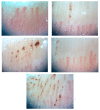Reversible Cerebral Vasoconstriction Syndrome and Raynaud's Phenomenon: Is There a Link between the Pathogeneses of Their Underlying Complex Etiology? A Case Report and Literature Review
- PMID: 37761318
- PMCID: PMC10528332
- DOI: 10.3390/diagnostics13182951
Reversible Cerebral Vasoconstriction Syndrome and Raynaud's Phenomenon: Is There a Link between the Pathogeneses of Their Underlying Complex Etiology? A Case Report and Literature Review
Abstract
Reversible cerebral vasoconstriction syndrome (RCVS) typically manifests as a sudden, severe thunderclap headache due to narrowing of the cerebral arteries. Symptoms usually resolve within three months. An imbalance in cerebral vascular tone, an abnormal endothelial function, and a decreased autoregulation of cerebral blood flow are thought to be involved in the pathogenesis of RCVS. However, the precise origin of this condition is not yet fully understood. Symptoms of Raynaud's phenomenon (RP) include vasospasm of arterioles of the digits. The pathophysiology of RP includes interactions between the endothelium, smooth muscle, and autonomic and sensory neurons that innervate arteries to help maintain vasomotor homeostasis. RP may occur before the clinical manifestation of a rheumatic condition. RCVS is rare in patients with autoimmune rheumatic disease. We describe a 54-year-old female who had a history of Raynaud's phenomenon affecting her fingers and toes since the age of 12 years. The patient was diagnosed with RCVS in 2012. She described RCVS precipitants, including the regular use of cannabis, cocaine, and amphetamine and tobacco smoking. In 2021, she presented with oral ulcers, intermittent swallowing difficulties, and Raynaud's phenomenon. Clinical examination revealed early sclerodactyly, and abnormal nail-fold capillaroscopy showed multiple giant capillaries, dilated capillary loops, and areas of capillary hemorrhage with capillary drop-out. The investigation revealed positive ANA, strongly positive SRP antibodies, and Ro60 antibodies. Our case report indicates that there may be a correlation between RCVS and Raynaud's phenomenon, and a potential connection between RCVS and autoimmune rheumatic diseases. Hence, physicians must be aware of the red flags and subtle differences in neurological abnormalities, such as headaches, in patients with autoimmune rheumatic diseases who have an inactive clinical status to improve patient care and outcomes.
Keywords: Raynaud’s phenomenon; autoimmune rheumatic diseases; nail-fold capillaroscopy; reversible cerebral vasoconstriction syndrome; systemic lupus erythematosus.
Conflict of interest statement
The authors declare no conflict of interest.
Figures
Similar articles
-
Reversible cerebral vasoconstriction syndrome (RCVS) in antiphospholipid antibody syndrome (APLA): the role of centrally acting vasodilators. Case series and review of literature.Clin Rheumatol. 2014 Dec;33(12):1829-33. doi: 10.1007/s10067-013-2434-9. Epub 2013 Nov 26. Clin Rheumatol. 2014. PMID: 24277114 Review.
-
Raynaud's phenomenon in common rheumatic diseases.Folia Med (Plovdiv). 2006;48(3-4):22-8. Folia Med (Plovdiv). 2006. PMID: 17668693 Review.
-
A Case Report of Reversible Cerebral Vasoconstriction Syndrome in a Patient With Systemic Scleroderma.Cureus. 2022 Apr 21;14(4):e24364. doi: 10.7759/cureus.24364. eCollection 2022 Apr. Cureus. 2022. PMID: 35619870 Free PMC article.
-
Raynaud's phenomenon and positive antinuclear antibodies as first manifestation of POEMS syndrome (polyneuropathy, organomegaly, endocrinopathy, monoclonal gammopathy, and skin changes): a case report.BMC Rheumatol. 2022 May 19;6(1):26. doi: 10.1186/s41927-022-00258-y. BMC Rheumatol. 2022. PMID: 35585632 Free PMC article.
-
Primary care assessment of capillaroscopy abnormalities in patients with Raynaud's phenomenon.Clin Rheumatol. 2015 Dec;34(12):2135-40. doi: 10.1007/s10067-015-3062-3. Epub 2015 Sep 23. Clin Rheumatol. 2015. PMID: 26400642
References
-
- Kayser C., Bredemeier M., Caleiro M.T., Capobianco K., Fernandes T.M., de Araújo Fontenele S.M., Freire E., Lonzetti L., Miossi R., Sekiyama J., et al. Position article and guidelines 2018 recommendations of the Brazilian Society of Rheumatology for the indication, interpretation and performance of nailfold capillaroscopy. Adv. Rheumatol. 2019;59:5. doi: 10.1186/s42358-018-0046-4. - DOI - PubMed
Publication types
LinkOut - more resources
Full Text Sources


